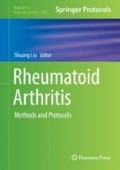Abstract
Autoantibodies that recognize self-antigens are believed to have close relationship diseases such as autoimmune diseases, cancer, and lifestyle diseases. Analysis of autoantibodies is essential for investigating pathology mechanisms, diagnosis, and therapeutics of these diseases. We developed autoantibody profiling assay using cell-free synthesized protein array and high-throughput screening technology. Our assay system can sensitively detect interaction between recombinant antigen protein and autoantibody and efficiently analyze autoantibody profiling in patients’ sera.
Access this chapter
Tax calculation will be finalised at checkout
Purchases are for personal use only
References
Scofield RH (2004) Autoantibodies as predictors of disease. Lancet 363:1544–1546
Jog NR, James JA (2017) Biomarkers in connective tissue diseases. J Allergy Clin Immunol 140:1473–1483
Lleo A, Invernizzi P, Gao B et al (2010) Definition of human autoimmunity—autoantibodies versus autoimmune disease. Autoimmun Rev 9:A259–A266
Sirotti S, Generali E, Ceribelli A et al (2017) Personalized medicine in rheumatology: the paradigm of serum autoantibodies. Auto Immun Highlights 8:10
Onishi S, Adnan E, Ishizaki J et al (2015) Novel autoantigens associated with lupus nephritis. PLoS One 10:e0126564
Wu J, Li X, Song W et al (2017) The roles and applications of autoantibodies in progression, diagnosis, treatment and prognosis of human malignant tumours. Autoimmun Rev 16:1270–1281
Meeusen E, Lim E, Mathivanan S (2017) Secreted tumor antigens: immune biomarkers for diagnosis and therapy. Proteomics 17:1600442
Ishigami T, Abe K, Aoki I et al (2013) Anti-interleukin-5 and multiple autoantibodies are associated with human atherosclerotic diseases and serum interleukin-5 levels. FASEB J 27:3437–3445
Takai K, Sawasaki T, Endo Y (2010) Practical cell-free protein synthesis system using purified wheat embryos. Nat Protoc 5:227–238
Sawasaki T, Hasegawa Y, Tsuchimochi M et al (2002) A bilayer cell-free protein synthesis system for high-throughput screening of gene products. FEBS Lett 514:102–105
Endo Y, Sawasaki T (2006) Cell-free expression systems for eukaryotic protein production. Curr Opin Biotechnol 17:373–380
Goshima N, Kawamura Y, Fukumoto A et al (2008) Human protein factory for converting the transcriptome into an in vitro—expressed proteome. Nat Methods 5:1011–1017
Takahashi H, Takahashi C, Moreland NJ et al (2012) Establishment of a robust dengue virus NS3-NS5 binding assay for identification of protein-protein interaction inhibitors. Antiviral Res 96:305–314
Nemoto K, Takemori N, Seki M et al (2015) Members of the plant CRK superfamily are capable of trans- and autophosphorylation of tyrosine residues. J Biol Chem 290:16665–16677
Morita M, Takashima E, Ito D et al (2017) Immunoscreening of plasmodium falciparum proteins expressed in a wheat germ cell-free system reveals a novel malaria vaccine candidate. Sci Rep 7:46086
Ullman EF, Kirakossian H, Switchenko AC et al (1996) Luminescent oxygen channeling assay (LOCI): sensitive, broadly applicable homogeneous immunoassay method. Clin Chem 42:1518–1526
Matsuoka K, Komori H, Nose M et al (2010) Simple screening method for autoantigen proteins using the N-TERMINAL BIOTINYLATED PROTEIN LIBRARY PRODUCED BY WHEAT CELL-FREE Synthesis. J Proteome Res 9:4264–4273
Sawasaki T, Kamura N, Matsunaga S et al (2008) Arabidopsis HY5 protein functions as a DNA-binding tag for purification and functional immobilization of proteins on agarose/DNA microplate. FEBS Lett 582:221–228
Mizutani Y, Tsuge S, Takeda H et al (2014) In situ visualization of plasma cells producing antibodies reactive to Porphyromonas gingivalis in periodontitis: the application of the enzyme-labeled antigen method. Mol Oral Microbiol 29:156–173
Mizutani Y, Matsuoka K, Takeda H et al (2012) Novel approach to identifying autoantibodies in rheumatoid synovitis with a biotinylated human autoantigen library and the enzyme-labeled antigen method. Phys Lett 387:1–14
Nagayoshi Y, Nakamura M, Matsuoka K et al (2014) Profiling of autoantibodies in sera of pancreatic cancer patients. Ann Surg Oncol 21(Suppl 3):S459–S465
Gibson DG (2011) Enzymatic assembly of overlapping DNA fragments. Methods Enzymol 498:349–361
Acknowledgments
The author would like to thank all collaborators and colleagues who conduct autoantibody profiling assay together. The author thanks Dr. Yohei Miyagi for his bioresource collection, Professor Tatsuya Sawasaki for his mentoring, and Wei Zhou for proofreading and valuable comments. This work was partially supported by Platform Project for Supporting Drug Discovery and Life Science Research (Basis for Supporting Innovative Drug Discovery and Life Science Research (BINDS)) from AMED, Japan.
Author information
Authors and Affiliations
Corresponding author
Editor information
Editors and Affiliations
Rights and permissions
Copyright information
© 2018 Springer Science+Business Media, LLC, part of Springer Nature
About this protocol
Cite this protocol
Takeda, H. (2018). Autoantibody Profiling Using Human Autoantigen Protein Array and AlphaScreen. In: Liu, S. (eds) Rheumatoid Arthritis. Methods in Molecular Biology, vol 1868. Humana Press, New York, NY. https://doi.org/10.1007/978-1-4939-8802-0_10
Download citation
DOI: https://doi.org/10.1007/978-1-4939-8802-0_10
Published:
Publisher Name: Humana Press, New York, NY
Print ISBN: 978-1-4939-8801-3
Online ISBN: 978-1-4939-8802-0
eBook Packages: Springer Protocols

